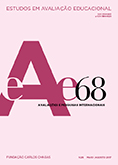Opportunity to learn the content of mathematics in Pisa 2012
DOI:
https://doi.org/10.18222/eae.v0ix.3905Keywords:
Pisa, Opportunity to Learn Content, Questionnaire, Mathematics.Abstract
The Programme for International Student Assessment] (Pisa) 2012 used student-level questionnaires to evaluate the Opportunity to Learn Content defined as students’ exposure to subject content in school – in this case, specifically in the area of Mathematics. Based on the results of the questionnaires, three indexes related to students’ performance in a group of countries were generated. The study suggests that there is a relationship between two of the indexes and the mean scores in the Mathematics test, but this relationship is weak for the third index. These results can elucidate aspects about exposure to mathematical tasks and concepts in the classroom which are not always well known.
Downloads
References
BRASIL. Instituto Nacional de Estudos e Pesquisas Educacionais Anísio Teixeira. Questionário A do estudante do Pisa 2012. Brasília, DF, 2013a. Disponível em: <http://download.inep.gov.br/acoes_internacionais/pisa/itens/2013/questionario_a_estudante.pdf>. Acesso em: 14 nov. 2016.
BRASIL. Instituto Nacional de Estudos e Pesquisas Educacionais Anísio Teixeira. Questionário B do estudante do Pisa 2012. Brasília, DF, 2013b. Disponível em: <http://download.inep.gov.br/acoes_internacionais/pisa/itens/2013/questionario_b_estudante.pdf>. Acesso em: 14 nov. 2016.
BRASIL. Instituto Nacional de Estudos e Pesquisas Educacionais Anísio Teixeira. Relatório nacional Pisa 2012: resultados brasileiros. Fundação Santillana, Brasília, DF, 2013c. Disponível em: <http://download.inep.gov.br/acoes_internacionais/pisa/resultados/2014/relatorio_nacional_pisa_2012_ resultados_brasileiros.pdf>. Acesso em: 14 nov. 2016.
CARROLL, J. B. A model of school learning. Teachers College Record, v. 64, n. 8, p. 723-733, 1963.
FIGUEIREDO FILHO, D. B.; SILVA JÚNIOR, J. A. Desvendando os Mistérios do Coeficiente de Correlação de Pearson (r). Revista Política Hoje, v. 18, n. 1, 2009. Disponível em: <http://www.revista.ufpe.br/politicahoje/index.php/politica/article/viewFile/6/6>. Acesso em: 14 nov. 2016.
GOMES, M. L. M. Ensino da Geometria no Brasil nas últimas décadas: da ausência à presença com prevalência das abordagens experimentais. Belo Horizonte: UFMG, 2007.
MASTERS, G. N.; WRIGHT, B. D. The Partial Credit Model. In: VAN DER LINDEN, W. J.; HAMBLETON, R. K. (Ed.). Handbook of Modern Item Response Theory. New York/Berlin/Heidelberg: Springer, 1997.
ORGANISATION FOR ECONOMIC CO-OPERATION AND DEVELOPMENT. Multinterative Data Selection Pisa 2012. Consulta de Banco de dados interativa. Disponível em: <http://pisa2012.acer.edu.au/interactive.php>. Acesso em: 14 abr. 2016.
ORGANISATION FOR ECONOMIC CO-OPERATION AND DEVELOPMENT. Pisa 2012 Results: ready to learn: student’s engagement, drive and self-beliefs. Paris: OECD, 2013a. v. III. Disponível em: <http://dx.doi. org/10.1787/9789264201170-en>. Acesso em: 14 nov. 2016.
ORGANISATION FOR ECONOMIC CO-OPERATION AND DEVELOPMENT. Pisa 2012 assessment and analytical framework: Mathematics, Reading, Science, Problem Solving and Financial Literacy. Paris: OECD, 2013b. Disponível em: <http://dx.doi.org/10.1787/9789264190511-en>. Acesso em: 14 nov. 2016.
ORGANISATION FOR ECONOMIC CO-OPERATION AND DEVELOPMENT. Pisa 2012 Results: what student’s know and can do: student performance in Mathematics, Reading and Science. Paris: OECD, 2014a. v. I. Disponível em: <http://dx.doi.org/10.1787/9789264208780-en>. Acessado em: 14 abr. 2016.
ORGANISATION FOR ECONOMIC CO-OPERATION AND DEVELOPMENT. Pisa 2012 technical report. Paris: OECD, 2014b. Disponível em: <http://www.oecd.org/ pisa/pisaproducts/pisa2012technicalreport.htm>. Acesso em: 14 nov. 2016.
ORGANISATION FOR ECONOMIC CO-OPERATION AND DEVELOPMENT. Education at a glance 2015: OECD indicators. Paris: OECD, 2015. Disponível em: <http://dx.doi.org/10.1787/eag-2015-en>. Acesso em: 14 nov. 2016.
Downloads
Published
How to Cite
Issue
Section
License
Copyright (c) 2017 Estudos em Avaliação Educacional

This work is licensed under a Creative Commons Attribution-NonCommercial 4.0 International License.
Authors who publish in this journal agree to the following terms:
a. Authors retain the copyright and grant the journal the right to first publication, with the paper simultaneously licensed under the Creative Commons Attribution license that allows the sharing of the paper with acknowledgment of authorship and initial publication in this journal.
b. Authors are authorized to assume additional contracts separately, for non-exclusive distribution of the version of the paper published in this journal (for example publishing in institutional repository or as a book chapter), with acknowledgment of authorship and initial publication in this journal.
c. Authors are allowed and encouraged to publish and distribute their paper on-line (for example in institutional repositories or on their personal page) at any moment before or during the editorial process, as this can generate productive changes, as well as increase the impact and citation of the published paper (See The Effect of Open Access).





